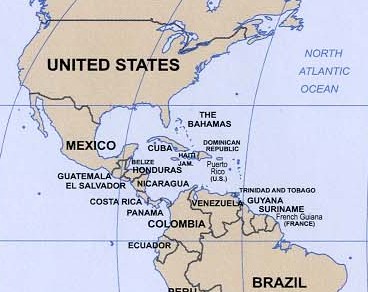
Part of the Western Hemisphere including Cuba and Colombia (same scale as above):

Anchoring and Adjustment
Method
Condition 1: The area of China is 9,396,960 square kilometers.
Condition 2: The area of Cuba is 110,860 square kilometers.
Part of the Eastern Hemisphere including China:

Part of the Western Hemisphere including Cuba and Colombia (same scale as
above):

What do you think the area of Colombia is?
.
.
.
.
.
.
.
Results
The actual area of Colombia
is 1,141,748 square kilometers.
Estimates when the anchor was...
China: Cuba:
2900000 980900
200000 400000
50000 197000
2500000 118975
3132320 567000
6000 110860
3000000 175000
5427312 910999
2500000 776020
4000000 330680
2349240
800000
5000000
|
TWO-SAMPLE T TESTS FOR ESTIMATE BY ANCHOR
SAMPLE
ANCHOR MEAN SIZE
---------- ---------- ------
China 2,450,000 13
Cuba 456,743 10
NULL HYPOTHESIS: DIFFERENCE = 0
ALTERNATIVE HYP: DIFFERENCE > 0
ASSUMPTION T DF P
----------------- ------ ------ ------
UNEQUAL VARIANCES 3.94 13.1 0.0008
|
Conclusions
When people make a quantitative estimate under uncertainty, they look for some quantity that they think is related and use it to help them make their estimate. They decide whether they should make an estimate greater or lesser than the related quantity, and then adjust it up or down accordingly in order to get their estimate. However, the related quantity acts as an anchor. In other words, they find it hard to adjust too far up or down, as if the anchor were holding them back. Therefore, if the anchor they start with is higher than what they think their estimate should be, they find it hard to adjust down far enough. If the anchor is lower, they find it hard to adjust up far enough. The result is that the average estimate made from a high anchor will be higher than the average estimate made from a lower anchor.